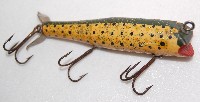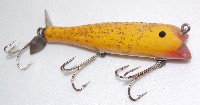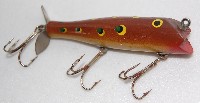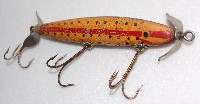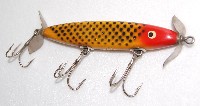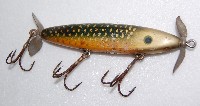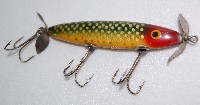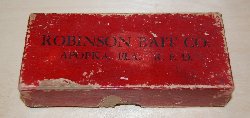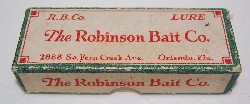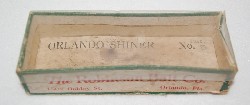|
Earl Robinson & The Robinson
Bait Company
Orlando, Florida |
Earl Robinson was one of Florida's early lure makers. He was living in Apopka, Florida when he started making folk art fishing lures in the mid 1920's. He later moved to Orlando and settled on two lure styles - the Best Yet Popper and the Orlando Shiner. Examples of Robinson's early and later work are shown below. The influence of Jim Pfeffer can clearly be seen in some of the Robinson Bait Company lures. |
| The lures shown here are part of our collection. Click on the thumbnail pictures to see a larger image |
| Robinson Bait Company Lure Boxes |
I wrote a story about Earl Robinson and his lures for the January 2011 edition of the Florida Antique Tackle Collectors Newsletter and also present it here: |
Earl Robinson Perfects His Baits When studying Florida’s earliest lure makers it is rare to hear their first hand accounts of designing and perfecting baits. In the course of doing some research last year I found a newspaper article that provides some very personal insight into Earl Robinson’s lure making. During a visit to St. Petersburg, Florida in early 1941, Robinson took the time for a newspaper interview with local outdoors writer Rubert Allyn. The story appeared in the St. Petersburg Times. |
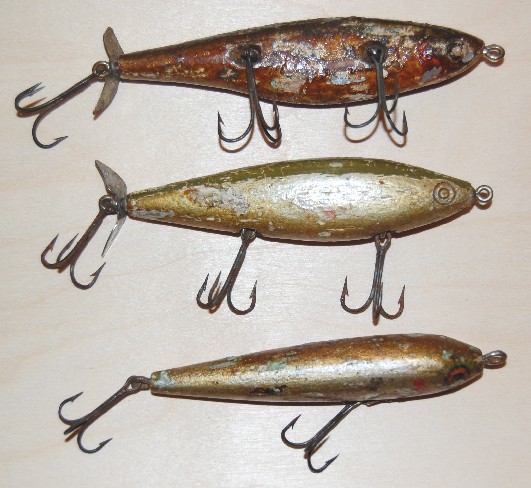 Earl Robinson Folk Art Lures |
Most of what we know about Earl Robinson comes from the definitive Florida Lure Makers and Their Lures by Brace, Riddle, and Stuart. They write that Robinson began making lures in Apopka, Florida sometime around 1926. His earliest baits were classic folk art, primitively carved, and hand painted in a rather dull palette of metallic and earth tone colors. The story continues that Robinson abandoned his folk art designs in favor of two distinctly new lures sometime around 1938. The authors refer to this as the Two Lure Period and it coincides rather nicely with the newspaper interview. |
| Rubert Allyn refers to Robinson as “the Apopka bait man” and says that “he started making baits in a trailer, and still makes his own stock and then sells around the state”. He writes “Earl Robinson…..is the man who’s been experimenting with bass baits up around Lake Apopka for the last two years. He finally has perfected what he believes is the answer to all bait problems”. A grainy photograph in the newspaper story is the only picture we have ever seen of Earl Robinson. |
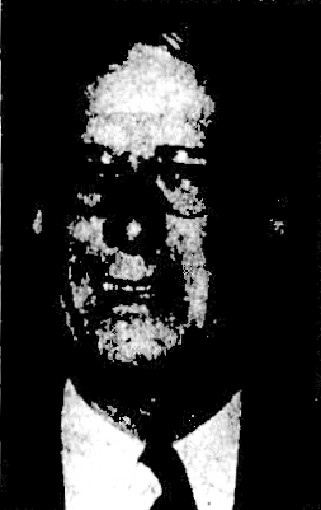 Earl Robinson |
| “Years ago,” Robinson explained, “I felt that bait makers were going a little off the track on ‘action’ for their plugs. You could hear the experts on every side talk of action, and more action. They wanted to make their baits dive and zip and turn barrel rolls in the water to lure the fish”. “Of course they caught some fish with all of the monstrosities, but really they were getting so much action into the plugs that a fish had to be trained to catch one. My experiments have proved that they’re all wet . . . absolutely all wet. It isn’t action they want, but a bait that moves slowly and gives the fish a chance to get it. It’s the finish and color that counts”. “My baits have absolutely no action at all. They move through the water on an even keel, and only the spinners make a disturbance. But the finish, and appeal . . . ah, that’s something else. That’s the thing. I’ve met fellows around tackle stores who say they can make this bait and that bait catch fish, but let me say right here that when you get right down to brass tacks they can’t produce. I’ve a standing offer that I’ll catch five for one from any of them, and they haven’t beaten me yet”. Robinson explained that it took a lot of trial and error to come up with the finish for his lures that worked. “I’ve seen hundreds of my efforts fade out in the water. The finish would peel off after a little use. It was only recently that I discovered the secret and now they work. It’s my secret and I’m going to keep it”. Some of Robinson’s colors and his secret finish are shown on the Best Yet Popper and Shiner lures of the Two Lure Period. |
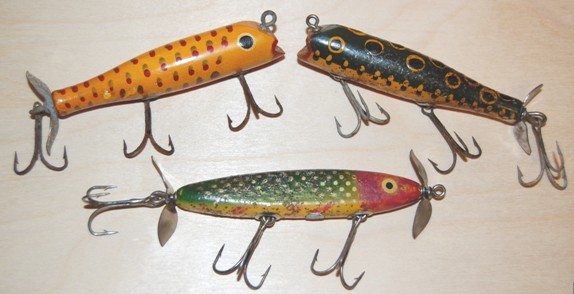 Earl Robinson Best Yet Poppers and Earl Robinson Shiner |
| I have spoken with a number of Robinson lure collectors over the years and heard them comment that it is hard to believe that the same man made the Two Lure Period baits and the folk art baits attributed to Earl Robinson. After all, the contrast in the lures is quite dramatic. How was it that crude carvings gave way to smoothly turned cedar bodies? How was it possible that lure color was not so important one day and a major ingredient the next? Robinson’s own words tell us that the changes represent the fruits of years of experimenting to learn what kind of lures work best to catch fish. Some people speculate that Robinson’s changes were made simply to improve his chances for commercial success. Chances are that both of these things are true. |
| We are always interested in adding to this collection. Please send an email if you have any old Robinson lures or boxes for sale or trade. Visit my page about Antique Florida Lures to see other lure makers from Florida. |
Copyright © Joe's Old Lures








